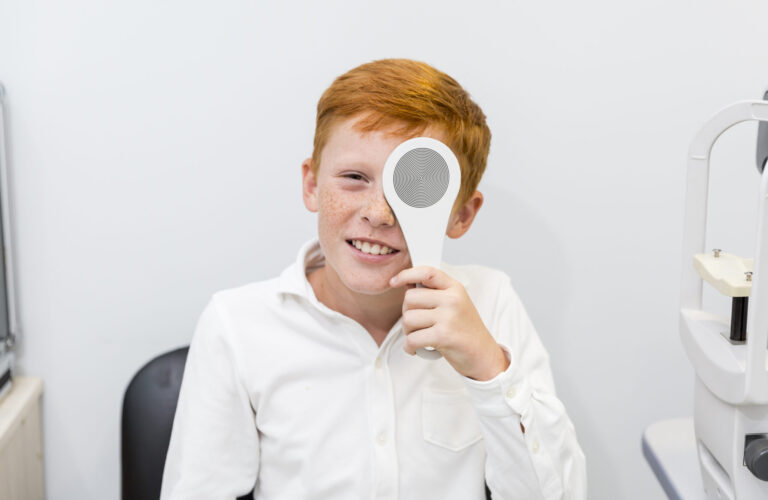Amblyopia: New Treatment Options with Light
Posted on 08 Oct. 2024 by Dr. Yvette Wang

About Amblyopia
Amblyopia, commonly known as “lazy eye,” is a vision condition that typically develops in childhood when the brain favors one eye over the other. As a result, the weaker eye doesn’t develop normal vision. If left untreated, amblyopia can lead to permanent vision loss in the affected eye. There are several common causes of amblyopia:
- Strabismus: This condition causes the eyes to point in different directions, with one eye focusing straight ahead while the other turns in, out, up, or down. To avoid double vision, the brain may ignore signals from the misaligned eye, causing it to become “lazy.”
- Refractive errors: If one eye is significantly more nearsighted, farsighted, or has more astigmatism than the other, the brain may rely more on the stronger eye. This can cause the vision in the weaker eye to develop improperly, even if the child seems to have normal vision when using both eyes.
- Cloudiness in the eye: Some children are born with a cataract, where the normally clear lens of the eye is cloudy. This prevents proper visual development in the affected eye.
- Droopy eyelid (Ptosis): When a child has a droopy eyelid, it can block vision in one eye, leading to amblyopia if left untreated.
The traditional approach to treating amblyopia involves strengthening the weaker eye by forcing the brain to use it. Common methods include:
- Patching the stronger eye: Covering the stronger eye helps the brain focus on using the weaker one, gradually improving its vision.
- Atropine eye drops: These drops temporarily blur vision in the stronger eye, encouraging the brain to rely more on the weaker eye.
- Vision therapy: Exercises aimed at improving eye coordination and visual processing can help the brain learn to use both eyes more effectively.
These treatments work best in young children during a critical period of visual development, usually before the age of 8 to 10 years.
New Treatment Option: Light Therapy
Recent research has explored the use of **light therapy**, or **photobiomodulation (PBM)**, as a novel treatment for amblyopia. Light therapy uses specific wavelengths of light to stimulate the cells in the retina and improve vision. This treatment is non-invasive, painless, and can be particularly beneficial for older children, teens, and adults who are beyond the critical period for traditional therapies.
Light therapy works by stimulating the mitochondria in the cells of the retina, increasing energy production and promoting cellular repair. This helps improve the brain’s ability to process visual signals from the weaker eye. The treatment is thought to boost communication between the eye and brain, allowing the weaker eye to regain some of its lost function.
Several clinical studies have shown promising results for light therapy in treating amblyopia, even in older patients. A study of 178 patients aged 13 to 72 found that light therapy significantly improved vision in most participants:
– 91% of patients with refractive amblyopia (due to vision differences between the eyes) improved by an average of 3 lines on a vision chart.
– 89% of patients with strabismus-related amblyopia saw an average improvement of 2.7 lines.
These improvements were maintained for at least six months after treatment, and no major side effects were reported.
Syntonic phototherapy is a specific type of light therapy that uses different colors of light to help balance the body’s autonomic nervous system. This therapy has been used for over 80 years to treat vision problems, including amblyopia and strabismus.
In syntonic phototherapy, different colored lights are chosen based on the patient’s condition:
– Blue light stimulates the parasympathetic nervous system, helping relax the visual system.
– Red light stimulates the sympathetic nervous system, improving focus and eye coordination.
Syntonic phototherapy has shown benefits in improving visual acuity, contrast sensitivity, and overall eye function. It can be used alongside other treatments like vision therapy or glasses for better results.
Summary
Amblyopia, or “lazy eye,” is commonly treated with methods like eye patching or vision therapy. However, these approaches are less effective in older children and adults. Light therapy offers a promising new treatment option by using specific wavelengths of light to improve cellular function in the retina. Clinical studies have shown significant improvements in vision for patients of all ages, with lasting effects and minimal side effects.
Syntonic phototherapy is another form of light therapy that can help balance the nervous system and improve vision. It has been used to treat amblyopia and other visual conditions with notable success.
If you or your child has amblyopia and traditional treatments haven’t worked, light therapy may be an option worth exploring. Always consult with your eye doctor to discuss the best treatment options for your condition.
